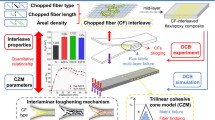Abstract
The objective of this study was to investigate strain-rate dependent energy absorption mechanisms during interlaminar fracture of thermosetting (epoxy) and thermoplastic (PEEK) uni directional carbon fibre (CF) composites. A simple model addressing the translation of matrix toughness to mode I and mode II interlaminar toughness of the composite is presented, in conjunction with a fractographic examination of the fracture surfaces and the fracture process. The observed rate dependency of composite fracture toughness is attributed to the rate dependent toughness of the viscoelastic matrix and the size of the process zone around the crack tip. Other important factors identified are the roughness of the fracture surface and fibre bridging.
Similar content being viewed by others
References
D. J. Wilkins, “The Engineering Significance of Defects in Composite Structures”, Conference Proceedings no. 355, Characterization, Analysis and Significance of Defects in Composite Materials organized by AGARD, 10–15. April 1983, London, UK.
D. L. Hunston,Comp. Tech. Rev. 4 (1986) 176.
A. J. Russell andK. N. Street, “Moisture and Temperature Effects on the Mixed Mode Delamination Fracture of Unidirectional Graphite/Epoxy”, Delamination and Debonding of Materials, ASTM STP 876 (American Society for Testing and Materials, Philadelphia, Pennsylvania, USA, 1985) p. 349.
W. S. Johnson andP. D. Mangalgirl “Investigation of Fiber Bridging in Double Cantilever Beam Specimens”, NASA TM 87716, April 1986.
W. L. Bradley andR. N. Cohen, “Matrix Deformation and Fracture in Graphite Reinforced Epoxies”, Delamination and Debonding of Materials, ASTM STP 876 (American Society for Testing and Materials, Philadelphia, Pennsylvania, 1985) (American Society for Testing and Materials, Philadelphia, Pennsylvania) p. 389.
H. H. Kausch, “Polymer Fracture” (Springer Verlag, New York, 1978).
A. J. Kinloch andR. J. Young, “Fracture Behavior of Polymers” (Elsevier Applied Science, London, 1983).
J. G. Williams, “Fracture Mechanics of Polymers” (Ellis, Horwood Chichester, 1984).
K. Friedrich, “Crazing in Shear Bands in SemiCrystalline Polymers”, in “Crazing in Polymers”, edited by H. H. Kausch (Springer Verlag, New York, 1983).
A. J. Smiley, M.S. Thesis, CCM-Report No. CCM-86-01, University of Delaware (1986).
A. J. Smiley andR. B. Pipes,J. Comp. Muter. 21 (1987) 670.
Idem, Comp. Sci. Tech. 29 (1987) 1.
L. A. Carlsson andR. B. Pipes, “Experimental Characterization of Advanced Composite Materials” (Prentice-Hall, New Jersey, 1987).
J. R. Gillespie Jr, L. A. Carlsson andA. J. Smiley,Comp. Sci. Tech. 28 (1987) 1.
L. A. Carlsson, J. W. Gillespie andB. R. Trethewey,J. Reinf. Plast. Comp. 5 (1986) 170.
R. A. Crick, D. C. Leach, P. J. Meakin andD. R. Moors,J. Mater. Sci. 22 (1987) 2094.
W. L. Bradley andW. M. Jordan, “The Relationship between Resin Ductility and Composite Delamination Fracture Toughness”, in Proceedings of International Sym posium on Composite Materials and Structures, edited by T. T. Loo and C. T. Sun (Technomic, Lancaster, USA, 1986) p. 445.
R. W. Lang, M. Heym, H. Tesch andH. Stutz, “Influence of Constituent Properties on Interlaminar Crack Growth in Composites”, in “High Tech — the Way into the Nineties”, edited by K. Brunsch, H. D. Golden and C. M. Herkert (Elsevier, Amsterdam, 1986) p. 261.
K. Friedrich, R. Walter, H. Voss andJ. Karger-Kocsis,Composites 17 (1986) 205.
J. Karger-Kocsis andK. Friedrich,Plastics Rubber Proc. Appl. 8 No. 2 (1987) 91–104.
A. J. Kinloch, S. J. Shaw, D. A. Tod andD. L. Hunston,Polymer 24 (1983) 1341.
Idem, ibid. 24 (1983) 1355.
D. Broek, “Elementary Engineering Fracture Mechanics,” 3rd Edn (Martinus Nijhoff, 1984).
L. Berglund, PhD thesis no. 54, Linkoping University, Sweden (1985).
E. M. Wu, “Strength and Fracture of Composites, Composite Materials”, Vol. 5 “Fracture and Fatigue”, edited by L. J. Broutman (Academic, New York, 1974) p. 191.
Author information
Authors and Affiliations
Rights and permissions
About this article
Cite this article
Friedrich, K., Walter, R., Carlsson, L.A. et al. Mechanisms for rate effects on interlaminar fracture toughness of carbon/epoxy and carbon/PEEK composites. J Mater Sci 24, 3387–3398 (1989). https://doi.org/10.1007/BF01139070
Received:
Accepted:
Issue Date:
DOI: https://doi.org/10.1007/BF01139070




